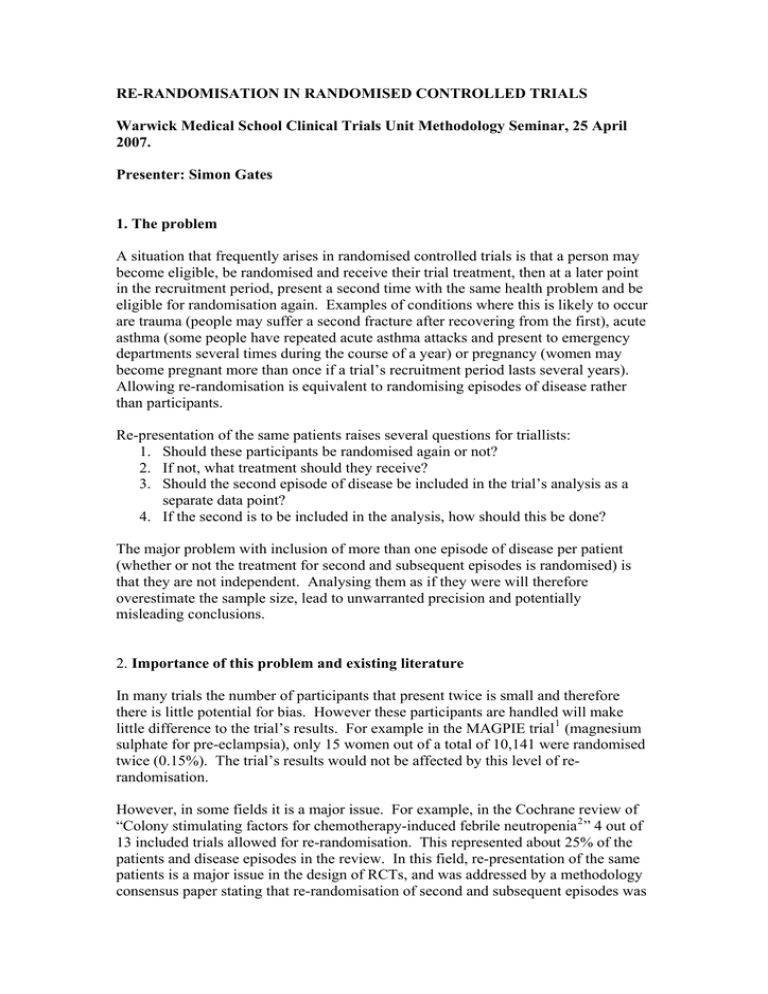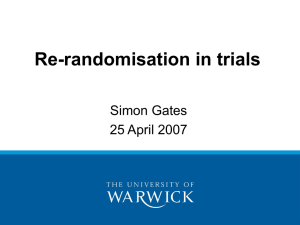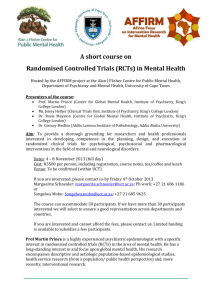RE-RANDOMISATION IN RANDOMISED CONTROLLED TRIALS
advertisement

RE-RANDOMISATION IN RANDOMISED CONTROLLED TRIALS Warwick Medical School Clinical Trials Unit Methodology Seminar, 25 April 2007. Presenter: Simon Gates 1. The problem A situation that frequently arises in randomised controlled trials is that a person may become eligible, be randomised and receive their trial treatment, then at a later point in the recruitment period, present a second time with the same health problem and be eligible for randomisation again. Examples of conditions where this is likely to occur are trauma (people may suffer a second fracture after recovering from the first), acute asthma (some people have repeated acute asthma attacks and present to emergency departments several times during the course of a year) or pregnancy (women may become pregnant more than once if a trial’s recruitment period lasts several years). Allowing re-randomisation is equivalent to randomising episodes of disease rather than participants. Re-presentation of the same patients raises several questions for triallists: 1. Should these participants be randomised again or not? 2. If not, what treatment should they receive? 3. Should the second episode of disease be included in the trial’s analysis as a separate data point? 4. If the second is to be included in the analysis, how should this be done? The major problem with inclusion of more than one episode of disease per patient (whether or not the treatment for second and subsequent episodes is randomised) is that they are not independent. Analysing them as if they were will therefore overestimate the sample size, lead to unwarranted precision and potentially misleading conclusions. 2. Importance of this problem and existing literature In many trials the number of participants that present twice is small and therefore there is little potential for bias. However these participants are handled will make little difference to the trial’s results. For example in the MAGPIE trial 1 (magnesium sulphate for pre-eclampsia), only 15 women out of a total of 10,141 were randomised twice (0.15%). The trial’s results would not be affected by this level of rerandomisation. However, in some fields it is a major issue. For example, in the Cochrane review of “Colony stimulating factors for chemotherapy-induced febrile neutropenia 2 ” 4 out of 13 included trials allowed for re-randomisation. This represented about 25% of the patients and disease episodes in the review. In this field, re-presentation of the same patients is a major issue in the design of RCTs, and was addressed by a methodology consensus paper stating that re-randomisation of second and subsequent episodes was an acceptable trial design. 3 Other diseases or patient groups where re-presentation is likely to be frequent are those where there is an acute problem that will resolve in a short period (days or hours), such as acute asthma attacks or epileptic seizures. Re-presentation is likely to occur in many trials. There is currently no agreed best practice and triallists and statisticians devote time and effort to dealing with it on a trial by trial basis. It therefore seems reasonable that an attempt to produce some general guidelines would be useful. There is almost no literature addressing the problems of re-presentation of patients and re-randomisation. One statistical paper has looked at the consequences of rerandomisation for meta-analyses. 4 3. Inclusion of patients on re-presentation There are arguments for and against including patients in a trial again on a second presentation. It helps to increase the recruitment towards the target sample size, and may improve patient and clinician satisfaction, if their first experience of the trial was good. However, it will introduce statistical complexity as it will need to be allowed for in the analysis. Failure to correct for non-independence adequately may introduce bias. There are two decisions to be made about patients’ second and subsequent presentations: 1. whether they will be included in the trial’s analysis as a separate data point; 2. how they will be allocated to one of the trial’s interventions. The first decision is whether a second presentation can contribute another data point for that patient to the trial. This is likely to depend on circumstances. In general it is not possible for a second episode of disease to contribute another data point if the first participation is not yet complete. For example, consider a trial of treatments for acute injury with follow-up at 12 months. It is quite possible for an individual to recover and re-injure themselves 9 months after their first randomisation. Because follow-up is not yet complete it would not be appropriate to include the second injury as another data point. The second decision is how patients should be allocated to treatments on their second presentation. Again, this is likely to depend on circumstances. The first option would be to randomise again. This will mean that approximately half of the patients (with equal randomisation to the two arms) will be allocated to the same treatment and half to the opposite treatment. A second option would be to allocate to the same treatment as the patient was originally randomised to. This may be the best option in the situation described above, where a patient has not yet completed follow-up. In this situation, allocating to a different treatment from that originally allocated could erode any differences in outcome between the groups (in a similar way to non-compliance with treatment). A third option would be to allocate patients to the opposite treatment from that originally received. This would allow within-person comparisons of treatments for those people who presented more than once, similar to a crossover trial. The decisions about how to handle repeated presentations need to consider whether second and subsequent presentations may be different in some systematic way from first presentations. The disease process may be qualitatively or quantitatively different for a second episode of disease (for example, repeated fractures of the same bone), or the treatment received in the first episode may affect recovery after the second. For inclusion of both episodes in a trial’s analysis, there need to be good grounds for believing that repeated episodes of disease are sufficiently similar, and that there are not “carry-over” effects. Any strategy for dealing with repeated presentations assumes that patients already included in the trial who present again can be identified. In practice, this may be difficult. In multicentre trials, recruitment is usually undertaken by clinicians remote from the trial co-ordinating centre, who do not have access to recruitment records. It is unlikely that they will be able to identify repeated presentations of the same individual, so patient may get recruited more than once even if this is prohibited by the trial protocol. The analysis will then have to consider how these patients should be handled. Analysis issues Inclusion of more than one data point from an individual in the analysis requires some form of statistical adjustment to allow for no-independence. If this is not done the sample size will be over-estimated and estimates of treatment effects will be too precise (i.e. confidence intervals will be too narrow). If there are very few individuals with multiple data points adjustment for nonindependence is probably unimportant as it will make only a very small difference to the results. This of course raises the question of how common does re-randomisation (or multiple data points) have to be for it to be necessary to take account of it in the analysis? This will depend on both the frequency of multiple participation and the correlation between the outcomes of each individual. The commonest analytical strategy is probably to ignore multiple presentations of the same patient, and include them all as it they were independent. This is strictly incorrect, but it is not possible to say in what proportion of trials this may have made a difference to the results. A second possible strategy is to include only one data point for each person. Thus if there are multiple participations, the second and subsequent data points are excluded from the analysis. This ensures non-independence of all the data, but there is a cost in terms of reduced sample size, and an intention-to treat issue of randomisations being excluded from the analysis. There is also an ethical dimension: is it acceptable to randomise (or otherwise include a patient in a trial) with the intention of ignoring the data? Multiple participations where patients receive the same treatment could be analysed like cluster randomised trials, using standard methods. These have been used for related situations like multiple pregnancies. 5 If there are multiple participations with varying treatments it is in principle possible to allow for individual differences in the analysis. Recommendations The probability of repeated presentations should be considered at the protocol/design stage and, if it is likely to occur, appropriate measures should be included in the trial. These will depend to some extent on its expected frequency. If it is expected to be rare (but will almost certainly occur at some stage) if may be sufficient simply to analyse all data points as if they were independent. Where re-presentations are expected to be rare and have a reasonable chance of being detected, they should be prohibited in the trial protocol, as they add complexity to the statistical analysis and interpretation while giving little benefit in terms of increased information. If re-presentation is expected to be common, the appropriateness of including more than one data point from each person needs to be considered. This will involve consideration of the whether there are any carry-over effects of the first episode of disease or treatment and how long they last, and other aspects of the trial design such as the duration of follow-up. Rules should be specified in the protocol for when and how inclusion of second and subsequent presentations should occur. For example, rerandomisation during follow-up should normally be prohibited, when second presentations will in most trials be allocated to continue their randomised treatment. 1 Altman D, Carroli G, Duley L, Farrell B, Moodley J, Neilson J, Smith D; Magpie Trial Collaboration Group. Do women with pre-eclampsia, and their babies, benefit from magnesium sulphate? The Magpie Trial: a randomised placebo-controlled trial. Lancet. 2002;359(9321):1877-90. 2 Clark OAC, Lyman G, Castro AA, Clark LGO, Djulbegovic B. Colony stimulating factors for chemotherapy induced febrile neutropenia. Cochrane Database of Systematic Reviews 2000, Issue 4. Art. No.: CD003039. DOI: 10.1002/14651858.CD003039. 3 Immunocompromised Host Society. The design, analysis, and reporting of clinical trials on the empirical antibiotic management of the neutropenic patient. Report of a consensus panel. J. Infect Dis 1990, 161(3):397-401. 4 Hozo I, Djulbegovic B, Clark O, Lyman GH. Use of re-randomized data in meta-analysis. BMC Med Res Methodol. 2005 May 10;5(1):17 5 Gates S, Brocklehurst P. How should randomised trials including multiple pregnancies be analysed? BJOG 2004; 111: 213-219.



